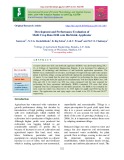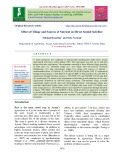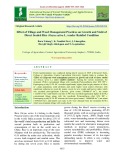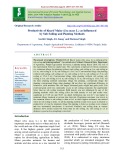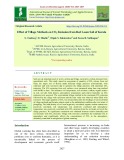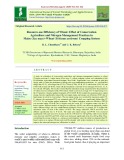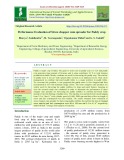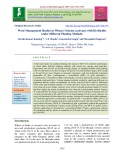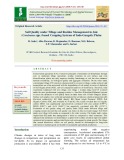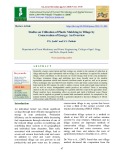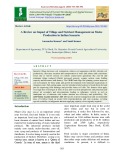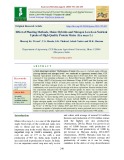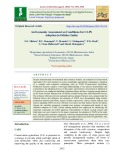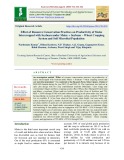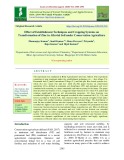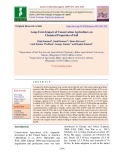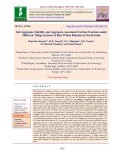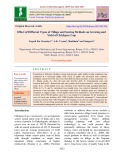
Minimum tillage
-
A tractor drawn roto drill cum herbicide applicator (RDHA) was developed during 2012- 13, at College of Agricultural Engineering, Bapatla. It was developed for adaption of minimum till technology and timeliness of and herbicide application operations. The RDHA was a combination of rotovator, seed hopper (Trough feed type) and rocker sprayer pump. It performs tillage, sowing and herbicide application simultaneously in single pass of tractor.
 9p
9p  cothumenhmong9
cothumenhmong9
 18-01-2021
18-01-2021
 12
12
 2
2
 Download
Download
-
A field experiment was conducted at Instructional-cum-Research (ICR) farm, Assam Agricultural University, Jorhat during 2016. The experiment was laid out in split-plot design with three replications. The treatments consisted of three different tillage practices in main plots viz.
 5p
5p  cothumenhmong9
cothumenhmong9
 18-01-2021
18-01-2021
 23
23
 2
2
 Download
Download
-
Keeping the above points in view the experiment was conducted to find out suitable tillage and weed management practices on growth and yield of direct-seeded rice.
 10p
10p  trinhthamhodang9
trinhthamhodang9
 16-12-2020
16-12-2020
 12
12
 1
1
 Download
Download
-
The experiment was laid out in split plot design with two factors namely, tillage practices and different conservation farming split with three replications. The treatment consisted of three tillage practices viz. T1- Conventional tillage, T2 –Minimum tillage and T3 – Summer plouging and five conservation farming viz. C1-Opening conservation, C2- Intercropping with redgram, C3-Mulching, C4-Herbicide application, C5-Combination of all treatments (C1+C2+C3+C4). Observations of crops are analyzed in Split plot design having three replications.
 13p
13p  angicungduoc8
angicungduoc8
 07-11-2020
07-11-2020
 16
16
 1
1
 Download
Download
-
The study was aimed to evaluate the effect of sub soiling and planting methods on maize productivity as well as on properties of the soil.
 9p
9p  quenchua8
quenchua8
 29-09-2020
29-09-2020
 8
8
 1
1
 Download
Download
-
Soils are an important pool of active carbon and tillage can lead to carbon emission from agricultural soils. This study aimed in assessment of quantity of CO2 release from red loam, the major soil of Kerala under different tillage practices (conventional, with cultivator and with rotovator) and to optimize the tillage practices with minimum CO2 emission. The CO2 emission from soil surfaces were measured using base trap method with NaOH as base.
 11p
11p  angicungduoc6
angicungduoc6
 22-07-2020
22-07-2020
 13
13
 2
2
 Download
Download
-
A study on evaluation of conservation agriculture and nitrogen management practices in wheat (Triticum aestivum L.) under maize ((Zea mays L.)-wheat cropping system was undertaken at the ICAR-Indian Agricultural Research Institute, New Delhi. Experiments were conducted in split-plot design with six main-plot treatments of tillage and crop establishment techniques, viz. conventional tillage-flat (CT-F), zero tillage-flat (ZT-F), CT-bed (CT-B), ZT-B, ZT-F with residue (ZT-F+R) and ZT-B with residue (ZT-B+R), while sub-plot treatments consisted of four nitrogen (N) levels, viz.
 16p
16p  angicungduoc6
angicungduoc6
 22-07-2020
22-07-2020
 16
16
 1
1
 Download
Download
-
Paddy is major crop of India. The grain to straw ratio in paddy crop is 1:1.25 and paddy crop generates huge amount of biomass and it alone contributes 34 % to total biomass production in India. Mostly combines are used for harvesting the paddy crop. The end use of paddy straw is not yet wide spread either on farm or in industrial sector. Thus straw management in combine harvested paddy fields is a major problem in paddy fields. To overcome this problem, it was proposed that paddy straw is first chopped and then incorporated in soil with minimum tillage efforts.
 7p
7p  angicungduoc6
angicungduoc6
 22-07-2020
22-07-2020
 9
9
 1
1
 Download
Download
-
A field experiment was conducted during rabi season of 2013-14 to study the performance of wheat under different planting methods with varied row spacing and herbicides.
 8p
8p  nguaconbaynhay6
nguaconbaynhay6
 24-06-2020
24-06-2020
 8
8
 0
0
 Download
Download
-
Conservation agriculture (CA) is based on principles of minimum soil disturbance through zero or minimum tillage operations, residue retention on soil surface and crop diversification which not only improves healthy functioning of soil but also enhances nutrient availability, its biological quality and aggregate formation. On the other hand, conventional tillage (CT) practices characterized by excessive tillage, residue removal and monoculture are often associated with the degradation of soil mainly in terms of depletion of Soil Organi arbon (SOC), sub-soil compaction and loss of biodiversity.
 8p
8p  angicungduoc5
angicungduoc5
 14-06-2020
14-06-2020
 10
10
 1
1
 Download
Download
-
Generally, energy conservation and fuel savings are related to the amount of reduction in tillage and may be quite substantial with no-tillage. Less machinery is required for reduced tillage, which contributes to the decrease in overall energy used in the crop production. No-tillage, minimum tillage and mulching have been broadly used in the modern agriculture operations which had showed excellent results in past as well as in present. These techniques have provided obvious benefits of soil and water conservation on sloping farm-land in the hill regions.
 9p
9p  angicungduoc5
angicungduoc5
 14-06-2020
14-06-2020
 11
11
 1
1
 Download
Download
-
Intensive tillage increases soil compaction, reduces soil aggregates stability, disrupts soil productivity, decreases retention and transportation of water and solutes and exacerbates losses due to run-off erosion. In contrast conservation agriculture like zero-till and minimum tillage (reduced tillable) increased porosity, organic carbon, water holding capacity and decreases bulk density.
 12p
12p  trinhthamhodang1213
trinhthamhodang1213
 29-05-2020
29-05-2020
 15
15
 0
0
 Download
Download
-
A field experiment entitled, “Performance of maize (Zea mays L.) hybrids under different planting methods and nitrogen levels” was conducted at Agronomy research farm, CCS Haryana Agricultural University, Hisar during kharif 2013 and 2014. The experiment consisted of four planting techniques viz. Raised Bed System (RBS), Flat Sowing with Zero Tillage (FSZT), Flat Sowing with Minimum Tillage (FSMT) and Flat Sowing with Conventional Tillage (FSCT) in main plots and two maize hybrids viz. HQPM-1 and HQPM-5 and three nitrogen levels viz.
 8p
8p  angicungduoc4
angicungduoc4
 26-04-2020
26-04-2020
 24
24
 0
0
 Download
Download
-
Despite demonstrated environmental and economic benefits, the adoption of Conservation Agriculture (CA) still remains low across smallholder agricultural communities. Adoption of a complex and composite technology such as CAPS (Conservation Agriculture Production System) requires a thorough understanding of site-specific determinants and constraints in the adoption process.
 15p
15p  kequaidan4
kequaidan4
 21-04-2020
21-04-2020
 27
27
 1
1
 Download
Download
-
An investigation entitled “Effect of resource conservation practices on productivity of maize intercropped with soybean under Maize + Soybean – wheat cropping system and soil microbial population” was conducted at the Research Farm, Main Campus, Chatha of SKUAST–Jammu during the year 2012-13 and 2013-14.
 11p
11p  nguathienthan4
nguathienthan4
 18-04-2020
18-04-2020
 10
10
 2
2
 Download
Download
-
The experiment was conducted at Bihar Agricultural University, Sabour. This experiment consisting of nine treatments under rice establishment techniques viz., - Zero tillage (T1), Permanent bed (T2)and Conventional Tillage (T3) and Sub-plot Rice based systems ricewheat (S1) rice- maize (S2) and rice- lentil (S3).The paper focuses on conservation agriculture (CA), defined as minimum soil disturbance (NT) and permanent soil cover combined with rotations, as a more sustainable cultivation system for the future.
 10p
10p  trinhthamhodang1212
trinhthamhodang1212
 06-04-2020
06-04-2020
 16
16
 1
1
 Download
Download
-
A long-term field experiment was carried out in alluvial soil with conservation agriculture practices like Zero tillage (ZT), Permanent bed (PB) and Conventional tillage (CT) to see the impact on Physico-chemical Properties of soil under rice based cropping systems. After completion of 7th cycle of experiment (2018), soil samples were collected from each plot and analysis processes were executed. The results obtained from the study show that the conservation agricultural practices increased the organic carbon 0.47 to 0.71%, cation exchange capacity 9.76 to 13.
 10p
10p  trinhthamhodang3
trinhthamhodang3
 22-02-2020
22-02-2020
 8
8
 0
0
 Download
Download
-
The influences of tillage systems on soil carbon (C) stocks have been studied extensively, but the distribution of soil C within aggregate fractions is not well understood. This review study was to determine the influences of various tillage systems on soil aggregation and aggregate-associated C under rice-wheat rotation in North India. The NT and RT treatments significantly increased the proportion of macro-aggregate fractions (>2000 and 250-2000μm) compared with the MP-R and MP+R treatments.
 19p
19p  chauchaungayxua3
chauchaungayxua3
 07-02-2020
07-02-2020
 16
16
 0
0
 Download
Download
-
A long-term field experiment was carried out in alluvial soil with conservation agriculture practices like Zero tillage, Permanent bed and Conventional tillage to see the impact on vertical distribution of DTPA-Zn and Organic carbon of soil under rice based cropping systems. After completion of 5th cycle of experiment (2016), soil samples were collected from each plot and analysis processes were executed. The results were revealed that vertical distribution of DTPA-Zn and Organic carbon content, decreased with increases of soil depth. Maximum DTPA-Zn (2.
 9p
9p  kethamoi2
kethamoi2
 15-12-2019
15-12-2019
 10
10
 1
1
 Download
Download
-
Evaluation of different chickpea sowing technologies under paddy residue conditions was conducted in a harvested paddy field. Field of paddy was harvested with combine. Chickpea variety (JG-130) was sown with different farm machines in four treatments viz., T1: Happy seeder, T2: Zero till seed cum fertilizer drill, T3: Conventional seed cum fertilizer drill and T4: Raised bed seed cum fertilizer drill in harvested R-1 variety of paddy fields. In T1, all the paddy straw was remained in the field itself and spreaded uniformly.
 5p
5p  cothumenhmong1
cothumenhmong1
 11-12-2019
11-12-2019
 14
14
 0
0
 Download
Download
CHỦ ĐỀ BẠN MUỐN TÌM









